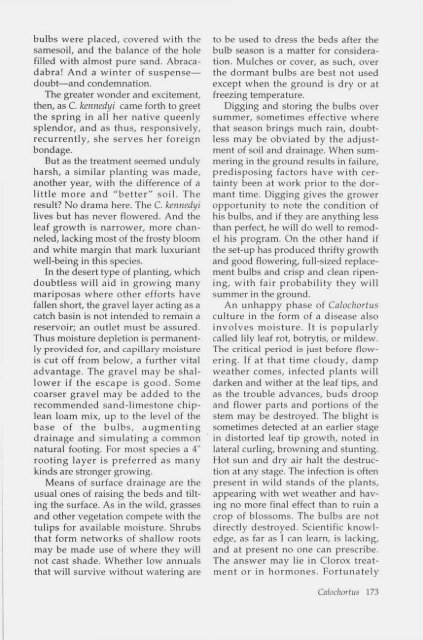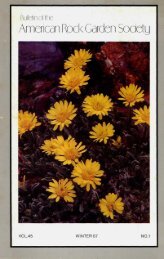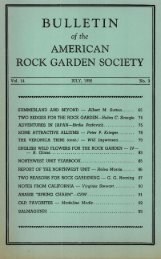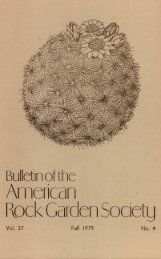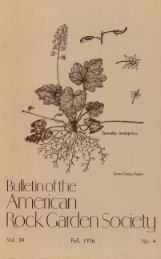Bulletin - Summer 1994 - North American Rock Garden Society
Bulletin - Summer 1994 - North American Rock Garden Society
Bulletin - Summer 1994 - North American Rock Garden Society
You also want an ePaper? Increase the reach of your titles
YUMPU automatically turns print PDFs into web optimized ePapers that Google loves.
ulbs were placed, covered with thesamesoil, and the balance of the holefilled with almost pure sand. Abracadabra!And a winter of suspense—doubt—and condemnation.The greater wonder and excitement,then, as C. kennedyi came forth to greetthe spring in all her native queenlysplendor, and as thus, responsively,recurrently, she serves her foreignbondage.But as the treatment seemed undulyharsh, a similar planting was made,another year, with the difference of alittle more and "better" soil. Theresult? No drama here. The C. kennedyilives but has never flowered. And theleaf growth is narrower, more channeled,lacking most of the frosty bloomand white margin that mark luxuriantwell-being in this species.In the desert type of planting, whichdoubtless will aid in growing manymariposas where other efforts havefallen short, the gravel layer acting as acatch basin is not intended to remain areservoir; an outlet must be assured.Thus moisture depletion is permanentlyprovided for, and capillary moistureis cut off from below, a further vitaladvantage. The gravel may be shallowerif the escape is good. Somecoarser gravel may be added to therecommended sand-limestone chipleanloam mix, up to the level of thebase of the bulbs, augmentingdrainage and simulating a commonnatural footing. For most species a 4"rooting layer is preferred as manykinds are stronger growing.Means of surface drainage are theusual ones of raising the beds and tiltingthe surface. As in the wild, grassesand other vegetation compete with thetulips for available moisture. Shrubsthat form networks of shallow rootsmay be made use of where they willnot cast shade. Whether low annualsthat will survive without watering areto be used to dress the beds after thebulb season is a matter for consideration.Mulches or cover, as such, overthe dormant bulbs are best not usedexcept when the ground is dry or atfreezing temperature.Digging and storing the bulbs oversummer, sometimes effective wherethat season brings much rain, doubtlessmay be obviated by the adjustmentof soil and drainage. When summeringin the ground results in failure,predisposing factors have with certaintybeen at work prior to the dormanttime. Digging gives the groweropportunity to note the condition ofhis bulbs, and if they are anything lessthan perfect, he will do well to remodelhis program. On the other hand ifthe set-up has produced thrifty growthand good flowering, full-sized replacementbulbs and crisp and clean ripening,with fair probability they willsummer in the ground.An unhappy phase of Calochortusculture in the form of a disease alsoinvolves moisture. It is popularlycalled lily leaf rot, botrytis, or mildew.The critical period is just before flowering.If at that time cloudy, dampweather comes, infected plants willdarken and wither at the leaf tips, andas the trouble advances, buds droopand flower parts and portions of thestem may be destroyed. The blight issometimes detected at an earlier stagein distorted leaf tip growth, noted inlateral curling, browning and stunting.Hot sun and dry air halt the destructionat any stage. The infection is oftenpresent in wild stands of the plants,appearing with wet weather and havingno more final effect than to ruin acrop of blossoms. The bulbs are notdirectly destroyed. Scientific knowledge,as far as I can learn, is lacking,and at present no one can prescribe.The answer may lie in Clorox treatmentor in hormones. FortunatelyCalochortus 173


